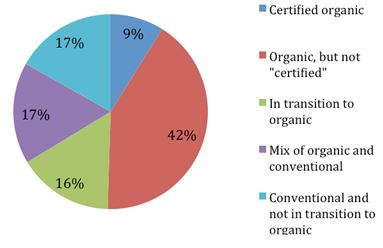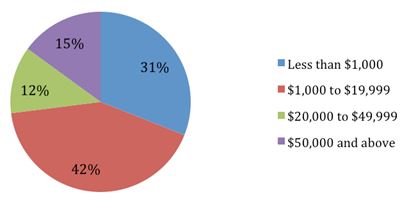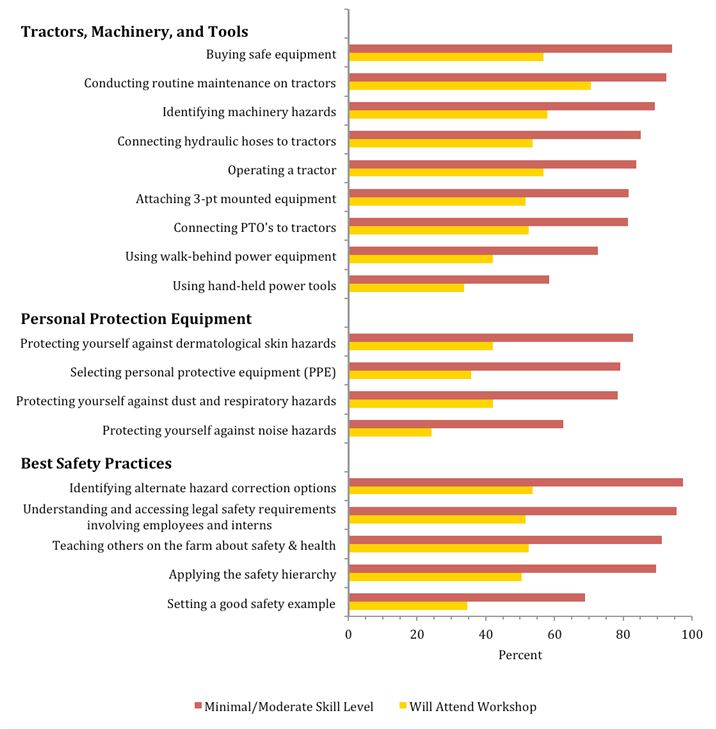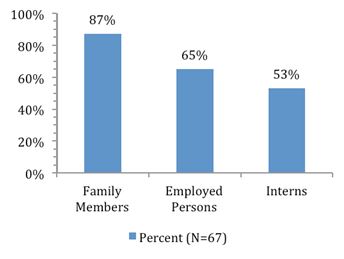 |
December 2013
|
December 2013 // Volume 51 // Number 6 // Feature // v51-6a10
Beginning Farmers: Will They Face Up to Safety and Health Hazards?
Abstract
The study reported here assessed the farm safety and health training needs of beginning farmers in Pennsylvania to help educators develop training workshops and materials to meet those needs. Results of the online survey indicate that participants highly value farm safety, consider themselves to have mostly minimal to moderate skills relative to the safe operation of farms, and are willing to attend safety training workshops. The results of the study provide direction to Extension educators in designing farm safety and health training for this growing constituent group.
Introduction
Despite the declining trend in the number of farms nationwide since World War II, the 2007 Census of Agriculture reveals that Pennsylvania had a greater than 5.1% increase in farms since 2002. Additionally, 26.5% of all principal farm operators have farmed for less than 10 years (U.S. Department of Agriculture, 2007). Beginning farmers and ranchers, those who have operated a farm or ranch either as a sole operator or with others who have operated a farm or ranch for 10 years or less (National Institute of Food and Agriculture, 2010), face many challenges. To offset the challenges of operating a new farm or ranch, recent initiatives funded by the USDA-NIFA New and Beginning Farmer and Rancher Development (NBFRD) program are developing resources to educate new farmers and ranchers about financial planning, marketing strategies, and the diversification and sustainability of crop and livestock production systems (Current Research Information System, 2010).
But farming is not only challenging from a business and production perspective, it is recognized as a dangerous occupation (Seiz & Downey, 2001; National Safety Council, 2009; U.S. Bureau of Labor Statistics, 2010). For example, in Pennsylvania between 2005 and 2009, at least 145 farmers, farm family members, hired workers, and others lost their lives due to farm-related fatal injury incidents, with the majority of these involving tractors and machinery (Murphy & Kassab, 2011). Adding to the danger of traditional farm work is that a generation of new farmers entering the industry may not comprehend the potential impact of the hazards because their previous sphere of knowledge and experience may be from other industrial or business settings where hazardous work conditions are less common. Research has shown that the viability of farm businesses depends upon the experience and expertise of the principal farmer (Kelsey, 1991).
Educational programs designed to specifically train new and beginning farmers and ranchers on safety and health hazards have been non-existent. At a recent annual meeting of NBFRP project directors, a compilation of funded projects from 45 states showed that a Penn State 3-year project funded in 2011 was the only program targeting agricultural workplace hazards (USDA-NIFA Beginning Farmer and Rancher Development Program: Project Director Meeting. Rochester, Minnesota, 12/5-6/2012). Educational resources are sorely needed so that new and beginning farmers can protect themselves and others on the farm from severe hazards related to tractors, equipment, and other risks to maintain farm sustainability and profitability.
To discover the training topics most appropriate for new and beginning farmers, we needed to hear from new farmers (Salmen, 1989). Because safety needs assessments from the past included all farmers (Brzozowski, 2010; Hope, Kelleher, Holmes, & Hennessy, 1999; Dewar, 1996; Horne, 1993), or relate to sub groups such as women farmers (Barbercheck et al., 2009) or dairy farmers (Trechter & Janke, 2012; Francesca, 2009), we conducted a needs assessment only among beginning farmers. We asked these farmers about their skill and preparedness levels to safely operate a farm; their interest in attending safety workshops; the extent of specific dangers on their farm; and their current safety training programs for employees on their farm.
Methodology
To collect the data for the needs assessment, we submitted an on-line survey to members of three organizations known to attract new and beginning farmers: Start Farming Pennsylvania; Pennsylvania Association for Sustainable Agriculture (PASA); and the Pennsylvania Women's Agricultural Network (PA WAgN). No national or state list existed from which to draw a random sample of new and beginning farmers. Each organization agreed to distribute our survey link to their members via e-mail followed by three reminders. Additionally, PASA posted the survey link on their Web site, and Start Farming Pennsylvania handed out a paper version of the survey at several workshops.
The training topics and interventions selected reflect hazards and risks identified in research and that have traditionally resulted in high rates of injury or death, including tractor overturns (Myers & Hendricks, 2010); power-take-off entanglements (Ewalt, 2012); and other farm machinery hazards, including hitching activities and public highway operations, lack of preparedness in handling farm emergencies, and absence of training of labor on the farm thus enhancing the content validity of the questions (Landsittel, Hard, Murphy, & Kiernan, 1998; Murphy, 2003). To further enhance the content validity, we gave the beginning farmers the opportunity to add a hazard not found in the literature in an open-ended question. To enhance both the validity and reliability of the needs assessment, we also drew on question formats found to be sensitive to variations among other farmers; we used the WAgN needs assessment (Barbercheck et al., 2009). To enhance concurrent validity and reliability, we used answer categories that included gradations from 4-5 categories in attitude questions. To enhance validity and reliability in all behavior questions, we included a time frame, e.g., 1 year, so that respondent would be consistent if they took the survey at a later time and so that consistency would be achieved across respondents as well (Sudman & Bradburn, 1982).
To ensure that our responses came from new farmers only, screening questions asked if the participant operates or works on a farm that fits the USDA description of a new farmer; how many years farming; and principal operator status on the farm. If an answer given did not meet the definition of a new farmer, the respondent became disqualified, and exited the survey. All others proceeded to answer closed- and open-ended questions described below.
Between January and April 2012, 95 people who met the definition of a new and beginning farmer completed the needs assessment.
Demographics and the Sample
For a profile of the beginning farmers besides operator status and years in farming, we asked about the farm's primary products or services; farming operation (organic vs. conventional); gross sales; and the farmer's age and gender.
Sole operator describes less than half of the beginning farmers (42%). But being one of two or more principal operators describes the larger segment (58%), an important factor in planning educational programs because more than one principal operator could lead to management confusion over safety responsibilities and limit follow-through on effective safety policies, training programs, and resources. The majority (71%) of survey respondents had started farming within the past 5 years.
Kind of Products and Services
Each of the new farms provides a wide diversity of products and services, with 42% providing four or more. That diversity covers two general areas of agriculture: 81% produce some plants/crops, and 68% raise animals (N=91). For a specific breakdown, see Table 1.
|
Products and Services |
Percentage of New Farmers N=91 | |
| Crop Production | Vegetables | 59 |
| Tree and small fruits, berries | 42 | |
| Greenhouse, nursery, and floriculture, cut flowers, and Christmas trees | 36 | |
| Hay, maple products, other plant crops | 28 | |
| Grains | 16 | |
|
Animal Production
|
Poultry and eggs | 68 |
| Sheep and goats | 26 | |
| Other animals: includes exotics (bison, emu, ostrich), bees, horses, llamas, and alpacas | 25 | |
| Cattle: dairy and beef | 22 | |
| Hogs and pigs | 16 | |
| Custom Operator | Support activities for crop production | 04 |
| Non-Farming Enterprises | Firewood | 15 |
| Construction, excavation, and welding | 07 | |
|
*Percents add to >100 as respondents were allowed to select multiple choices. |
||
Farm Operation and Sales
Two other demographics helped to characterize the new farmer respondents. A vast majority (83%) participates in organic farming at some level (Figure 1). Additionally, a large majority of farms (73%) grossed under $20,000 in the past year (Figure 2).
Figure 1.
Levels of Participation in Organic Farming

Figure 2.
Value of Farm Gross Sales in the Past Year

Beginning Farmers
Seventy-eight percent of our beginning farmer respondents ranged between 30-59 years of age (Figure 3). This correlates closely with the fact that beginning farm operators nationally are younger on average than farm operators overall (U.S. Department of Agriculture, 2007). Sixty-two percent of the new farmers responding to our survey were female.
Figure 3.
Age Categories of Beginning Farmers

Findings
Perspectives About Safety
Farm Safety in General
First, to determine the new farmers' view toward the value of having a "safe and healthful workplace," we asked about its importance in relation to three other values "profitability," "environmental stewardship," and "community acceptance of your farming practices." In response to "How important are each of the following values to you at this time?" they selected from "not so important," "slightly important," "somewhat important," "moderately important," and "very important." Second, we asked if they would be willing to assess safety aspects on their individual farms using a do-it-yourself checklist.
Almost all of the new farmers reported "very important" or "moderately important" for a "safe and healthful workplace" (98%), above the other values of "environmental stewardship" (95%), "profitability" (74%), and "community acceptance of your farming practices" (72%), indicating safety and health to be a priority for their farm. Additionally, 96% reported willingness to assess safety aspects of their farm using a do-it-yourself checklist.
Specific Dangers on the Farm
To discover the perception that new farmers had about common workplace hazards on the farm, we asked, "To what extent do you think each danger affects either you, your family, or any employees?" with response options of "n/a," "not at all," "minimally," "moderately," "considerably." The beginning farmers understand that dangers do exist on their farms with some dangers perceived more strongly than others (Table 2).
|
Dangers on Farm |
% Affected "Considerably" or "Moderately" |
N |
|
| Tractors, Machinery and Tools | Tractor use | 92 | 72 |
| Field machinery and equipment | 91 | 79 | |
| Operating farm equipment on public roads | 26 | 63 | |
| Using a chain saw | 79 | 85 | |
| Shop equipment and tools | 73 | 85 | |
| Others | Handling animals | 67 | 76 |
| Presence of children on the farm | 64 | 70 | |
| Noise-induced hearing loss from farm machinery | 56 | 86 | |
| Handling and using other chemicals (e.g. fertilizers, barn chemicals, fuels, etc.) | 49 | 78 | |
| Handling and using pesticides | 45 | 64 |
We found no systematic difference in how men and women farmers perceived dangers on the farm. But in one specific area, presence of children on the farm, we found a substantial difference. Women farmers were more likely than men to identify this as "considerably" dangerous (42.5% vs. 24.0%).
Training Topics and Willingness to Attend Workshops
To identify the topics on which to focus our agricultural safety training and resource materials development for new and beginning farmers, we assessed a broad array of their skills in operating a farm safely; their preparedness for handling farm emergencies; and their training of any employees on their farms. Additionally, to understand our respondents' potential commitment to experiential (hands-on, interactive) safety training, we assessed their willingness to attend workshops on the topics that they had selected.
Skills
To identify the topics in which the beginning farmers lacked safety skills and knowledge, we asked them to indicate their current level of skill on 18 farming operations involving tractors and equipment; personal protective equipment; and best safety practices. The response categories included "n/a (not applicable)," "minimal," "moderate," and "considerable." Following each of the 18 potentially hazardous operations, we asked, "Would you attend a hands-on workshop at a local farm in the next two years?"
The findings indicate that beginning farmers have a strong need for training in almost all topics in tractors and equipment, personal protection equipment, and best safety practices as over 60% demonstrate skill levels of just "minimal" or "moderate" (Figure 4). At least 40% indicated they would attend a workshop in 14 of the 18 operational topics.
Figure 4.
Percentage of Beginning Farmers With Minimal or Moderate Skill in Topics Important for Operating Farms More Safely and Percent Willing to Attend a Hands-On Workshop in Each Topic Within 2 Years

Looking at gender differences, we did not find a systematic difference between men and women farmers; however, substantially more women than men (at least 20% or more) revealed "minimal" levels and thus a greater need for training in these (8) selected topics: conducting routine maintenance on tractors; identifying machinery hazards; selecting personal protective equipment (PPE); identifying alternate hazard correction options; applying the safety hierarchy; connecting hydraulic hoses to tractors; using hand held power tools; and using walk behind power equipment. These findings support (Barbercheck et al., 2009) that women farmers want training in equipment and maintenance. Substantially more men than woman (21.5% more) revealed "minimal" levels and thus a greater need for training in one topic: teaching others on the farm about safety and health.
In an open-ended question, we asked the beginning farmers to identify skills they would like to acquire to operate their farm more safely. Over and beyond the skills listed above, beginning farmers identified improvement in safe animal skills (being prepared for animal behaviors, health, handling, husbandry, and transportation). Other skills mentioned included silo and electrical safety. Many respondents completed this question, thus enhancing the content validity of the needs assessment.
Preparedness to Handle Emergencies
To investigate the degree to which new farmers are prepared to face emergencies, we asked if they have a first-aid kit readily available in all work areas; if they are currently certified in first aid or CPR; and how often they checked fire extinguishers for proper charge during the past year, with answer options of "no extinguishers," "not at all," "one time," "twice," "every month." Overall, the new farmer respondents were not prepared to handle fire or first-aid emergencies (Figure 5).
Figure 5.
Percent of the New Farmers Not Prepared to Handle Fire and Health Emergencies on the Farm (N=90-91)

Current Training of Labor on the Farm in Safe Machinery and Equipment Use
If the new farmers indicated that people (including family members) work on their farms, we investigated the types of workers and the degree to which the workers received farm safety training over the past year, asking:
- The number of "employed persons," "interns," and "family members."
- How often did all new workers receive training within the first week on the job in safe machinery and equipment use? Responses: "no new workers," "not at all," "sometimes," "most times," "always."
- How often did all experienced workers (including family members) receive training in safe machinery and equipment use? Responses: "no other workers," "not at all," "one time," "twice," "three or more times."
Seventy-one percent of the new farmers reported having workers other than themselves on their farm in the last year, a finding that augments the question of their training in safety. These workers included a high percentage of family members, employed persons, and interns (Figure 6). Participants had up to seven family members, 10 employed persons, and seven interns working on their farm operations.
Figure 6.
Percent of Family Members, Employed Persons, and Interns Working on Farms Operated by the Beginning Farmers in the Past Year

Of the beginning farmers who had workers on their farm in the past year, women farmers were substantially more likely than men farmers in this sample to have employed workers and interns (76.2% vs. 50% and 68.2% vs. 32.2% respectively), but men farmers were more likely than the women farmers to have family workers (100% vs. 78.8% respectively). Other research on women farmers also reveals their reliance on interns (Barbercheck et al., 2009).
Despite the high percent of people working on these farms, however, the beginning farmers provided inadequate training for their workers in safe machinery and equipment use. Both early training with new workers and on-going training for experienced workers (including family members) did not fulfill current best practices for training. In the past year just 36% of the beginning farmers "always" trained new workers within the first week on the job in safe machinery and equipment use (N=67). And almost half (44%) did not provide training "at all" to all experienced workers (including family members) in safe machinery and equipment use.
Summary of Findings and Implications
The findings reveal that new farmers believe in the value of a safe and healthful workplace, have a willingness to assess safety on their farm using a do-it-yourself checklist, and believe that an array of 10 common dangers on the farm affects them, their families, and employees. These views are compelling and provide Extension educators with a strong base for believing in the feasibility of a training program in agricultural safety and health for beginning farmers.
The findings reveal also that beginning farmers lack skills needed to operate a farm safely, to handle emergencies on the farm, and to provide adequate training for labor on the farm—the latter a serious omission because many beginning farmers rely on employees, family, and interns for labor. The breadth of these findings validates the need for Extension educators to develop a comprehensive training program across the topics measured in the needs assessment.
Discovering that beginning farmers will attend hands-on trainings within the next 2 years provides Extension educators with a strong incentive to create a training program in agricultural safety and health for beginning farmers in the near future.
The sample of beginning farmers in the study reported here is purposive, selected because they have insight and experience in the areas of interest, and the findings cannot be generalized to other beginning farmers. However, the findings are valid for this group (Patton, 2002). Further research is needed to demonstrate that the findings apply to the larger population of beginning farmers. Despite this limitation, the report of the study contributes to the literature: it is the first on the topic of safety among beginning farmers, a new segment of American agriculture!
In summary, answering the question posed in the title, the findings make it clear that beginning farmers, given the training opportunity, will face up to the safety and health hazards on their farm. This action can enhance profitability and help sustain an infusion of beginning farmers in American agriculture. We integrated the needs assessment questions and answer categories into this article for use by other Extension educators for replication in measuring the safety needs of beginning farmers in other areas of the country.
References
Barbercheck, M., Brasier, K. J., Kiernan, N. E., Sachs, C., Trauger, A., & Findeis, J. (2009). Meeting the Extension needs of women farmers: A perspective from Pennsylvania. Journal of Extension [On-line], 47(3), Article 3FEA8. Available at: http://www.joe.org/joe/2009june/a8.php
Brzozowski, R. J. (2010). Final report: Assessing the farm safety needs of farmers & farm workers in Maine. Submitted to Northeast Center for Agricultural & Occupational Health (NEC). Retrieved from: http://umaine.edu/agriculture/programs/farm-safety/farm-safety-needs-report/
Current Research Information System. (2010). Abstracts of currently funded projects. Retrieved from: http://cris.csrees.usda.gov
Dewar, D. M. (1996). Farm health and safety issues: Do men and women differ in their perceptions? AAOHN Journal, 44(8), 391-401.
Ewalt, K. (2012). Reminders for farm safety. Michigan State University Extension. Retrieved from: http://www.agriview.com/news/regional/reminders-for-farm-safety/article_56928346-c13
Francesca, U. (2009). A farm safety training program on human risk management for dairy producers using a labor force including Hispanic workers. Retrieved from: http://agbiopubs.sdstate.edu/articles/FS950.pdf
Hope, A., Kelleher, C., Holmes, L., & Hennessy, T. (1999). Health and safety practices among farmers and other workers: A needs assessment. Occupational Medicine, 49(4), 231-235.
Horne, A. G. (1993). Agricultural safety and health series: On-site farm safety survey. (CR-1719). Oklahoma Cooperative Extension Service.
Kelsey, T. W. (1991). Fatal farm accidents in New York: Estimates of their costs. Northeastern Journal of Agricultural and Resource Economics, 20, 202-207.
Landsittel, D., Hard, D. L., Murphy, D. J., & Kiernan, N. E. (1998). The Pennsylvania Central Region farm safety pilot project: Part II—Baseline data associations between approach-to-safety and hazard conditions. Journal of Agricultural Safety and Health, (Special Issue No. 1), 21-28.
Murphy, D. J., & Kassab, C. (2011). Pennsylvania farm fatalities during 2005-2009. [Circular]. Penn State Extension.
Murphy, D. J., (2003). Looking beneath the surface of agricultural safety and health (p. 112). St. Joseph, MI: American Society of Agricultural Engineers.
Myers, J. R., & Hendricks, K. J. (2010). Agricultural tractor overturn deaths: Assessment of trends and risk factors. American Journal of Industrial Medicine, 53(7), 662-672.
National Institute of Food and Agriculture. (2010). Beginning farmers and ranchers development program (BFRDP). Retrieved from: http://www.csrees.usda.gov/fo/beginningfarmerandrancher.cfm
National Safety Council. (2009). Injury facts. Itasca: Natl Safety Council.
Patton, M. Q. (2002). Qualitative research and evaluation methods. Thousand Oaks, CA: Sage Publications.
Salmen, L. F. (1989). Listen to the people: Participant-observer evaluation of development projects. New York: Published for the World Bank by Oxford University Press.
Siez, R. C., & Downey, E. P. (2001). What farm families tell us that can be useful in educating for health and safety. Journal of Extension [On-line], 39(6), Article 6FEA5. Available at: http://www.joe.org/joe/2001december/a5.php
Sudman, S., & Bradburn, N. M. (1982) Asking questions: A practical guide to questionnaire design. San Francisco: Jossey Bass.
Trechter, D., & Janke, J. (2012). Dairy safety survey, 2012. University of Wisconsin-River Falls, Survey Research Center Report 2012/8. Retrieved from: http://www.uwrf.edu/SurveyResearchCenter/Publications/upload/Dairy-Safety-Survey-Report-final.pdf
U.S. Bureau of Labor Statistics. (2010). 2009 census of fatal occupational injuries (CFOI) - Current and revised data. Retrieved from: http://www.bls.gov/iif/oshcfoi1.htm
U.S. Department of Agriculture. (2007). 2007 Census of agriculture: Summary by tenure of principal operator and by operators on farm. Retrieved from: http://www.agcensus.usda.gov/Publications/2007/Full_Report/Volume_1,_Chapter_1_State_Level/Pennsylvania/st42_1_065_065.pdf




